
Why do people think keeping an emergency kit means they should hoard tuna, salt, and bottled water?
After all, there is a grocery store on every corner, right?
While it may seem silly to prepare for an emergency, it is a good idea to have a plan.
Here’s the truth:
Climate change and other atmospheric changes taking place have caused an increasing lack of predictability in our weather.
With that, we are besieged with superstorms, polar vortexes, tornadoes, and other damage-inducing weather phenomena.
If you don’t have an emergency plan, it’s time to start thinking about it.
More than that:
You need to do something about it.
- Does your family have a plan for hurricanes?
- Earthquakes?
- Tornadoes?
- Blizzards or extensive winter storms?
- Extended power outages or “shelter in place” orders?
It might never happen to you, but it might.
So, your plan should include assembling an emergency kit, or Bug Out Bag (BOB).
Oh, and your BOB doesn’t need 52 cans of tuna.
Unless, of course, you have 52 cats.
The Likelihood of Experiencing a Natural Disaster
Natural Disaster is defined as:
“a sudden and terrible event in nature (such as a hurricane, tornado, or flood) that usually results in serious damage and many deaths”
Maybe we can blame it on the internet and our increased access to information.
Perhaps it is the fault of the effects of Global Climate Change.
“A natural disaster is an act of nature of such magnitude as to create a catastrophic situation in which the day-to-day patterns of life are suddenly disrupted and people are plunged into helplessness and suffering, and, as a result, need food, clothing, shelter, medical and nursing care and other necessities of life, and protection against unfavourable environmental factors and conditions.”
~Guide to sanitation in natural disasters World Health Organization (1971)
Maybe Mother Earth is tiring of the human parasites infecting her body and is fighting back.
Whatever you believe is the cause, the fact remains:
Natural disasters are gaining in frequency.
According to the EM-DAT, the total natural disasters reported each year has been steadily increasing in recent decades, from 78 in 1970 to 348 in 2004.”
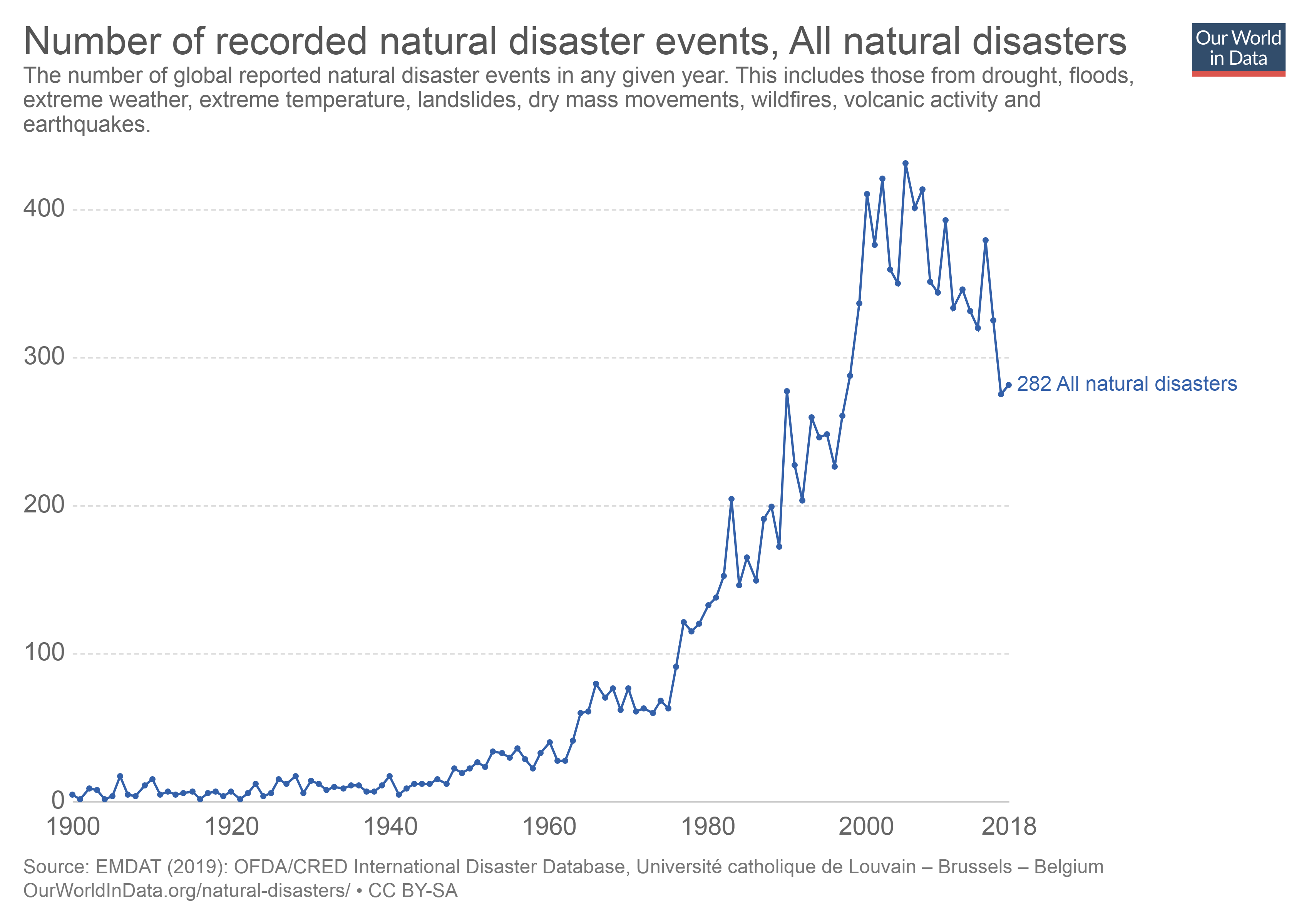
Image source: CC BY-SA 4.0 via Our World in Data
That is STAGGERING.
The devastating effects of a natural disaster may be directly related to where you live within the United States.
But you have to :
Pay attention and not ignore the need to have a plan if you live in a “safe” area.

Source: Tradingfloor
Hurricanes
A tropical cyclone with winds of 74 miles (119 kilometers) per hour or greater that occurs especially in the western Atlantic, that is usually accompanied by rain, thunder, and lightning, and that sometimes moves into temperate latitudes”
The number of hurricanes recorded varies from year to year, and they generally begin as tropical storms.
But then:
They intensify and move through the categories of hurricane classifications.
The World Meteorological Organization even gives them nifty names.
“For Atlantic hurricanes, there is a list of male and female names which are used on a six-year rotation. The only time that there is a change is if a storm is so deadly or costly that the future use of its name on a different storm would be inappropriate.”
But these storms can be devastating, and you need to prep.
The truth is:
Deaths that occur after a storm due to starvation, poisoned drinking water, and other factors can significantly increase the death count.
What the official numbers don’t tell us:
Consider Hurricane Maria, which ripped through Puerto Rico in 2018.
After claiming the “official” recorded deaths at 64 for months, the governor raised that number to 2,975 in August 2018.
The “unofficial” deaths since the event could number much higher.
Source links:https://www.cnn.com/2018/08/28/health/puerto-rico-gw-report-excess-deaths/index.htmlhttps://www.cnn.com/2018/05/29/us/puerto-rico-hurricane-maria-death-toll/index.html
Tornadoes
A tornado is:
“a violent destructive whirling wind accompanied by a funnel-shaped cloud that progresses in a narrow path over the land”
Many tornadoes go unreported:
Because of that, there is no accurate record of how many tornadoes occur each year in the United States.
But with that said:
There are an estimated 1,000 tornadoes each year.
The states most impacted by tornadoes are:
- Alabama
- Arkansas
- Florida
- Georgia
- Illinois
- Indiana
- Iowa
- Kansas
- Louisiana
- Mississippi
- Missouri
- Nebraska
- Oklahoma
- South Dakota
- Texas
Source link — https://scienceline.ucsb.edu/getkey.php?key=1073
Not So Fun Fact
Oklahoma averages more than 50 tornadoes each year.
In the U.S., tornadoes are responsible for about 60 deaths per year.
But not how you think:
Most people die from the result of falling or flying debris.
Earthquakes
The definition of an earthquake is:
“a shaking or trembling of the earth that is volcanic or tectonic in origin”
Earthquakes are occurring almost constantly.
In fact:
There are roughly 900,000 earthquakes around the world each year.
Fortunately, the number of deaths recorded in the U.S. from earthquakes is very low.
The states most impacted by earthquakes are:
- Alaska
- Arkansas
- California
- Hawaii
- Idaho
- llinois
- Kentucky
- Missouri
- Montana
- Nevada
- Oregon
- South Carolina
- Tennessee
- Utah
- Washington
- Wyoming
Source link — https://time.com/3002710/earthquake/
Wait, did we miss Oklahoma?
They have some issues too.
And this is why:
A recent uptick in seismic activity in some states is suspected to be caused by the disposal of wastewater in deep fracking wells.
“Injection-induced earthquakes are challenging to incorporate into hazard models because they may not behave like natural earthquakes and their rates change based on man-made activities,”
Areas not typically prone to earthquake activity, such as Oklahoma, are experiencing increased seismic activity.
Forest fires
While the jury is still out on whether or not forest fires are considered natural disasters, the fact remains that they can cause a lot of damage.
The technical definition of a forest fire is:
“an uncontrolled fire in a wooded area”
In 2017 alone:
There were 71,500 wildfires.
The total areas burned was 10 MILLION acres.
The average over 10 years is 6.6 million acres burned.
Surprising Fact
More wildfires occur in the Eastern U.S., But more acreage is destroyed in the West.
The states most impacted by wildfires are:
The states most impacted by earthquakes are:
- Alaska
- Arizona
- California
- Colorado
- Idaho
- Montana
- New Mexico
- Nevada
- Oregon
- Utah
- Washington
- Wyoming
Source link — https://fas.org/sgp/crs/misc/IF10244.pdf
If you live in a state prone to forest fires, you know that air quality is one of the most significant impacts during an active fire.
Smoke can travel for miles.
Deaths from wildfires, since 1970, number over 700, and many were firefighters.
But some were homeowners, reluctant to leave their homes.
Technically “not” natural disasters
Some weather phenomena can be devastating.
Even though these storms don’t qualify as official natural disasters, their effects can still cause property damage and loss of life.
Let us continue:
Polar Vortex in the midwest
If you live in the midwest, you’ve been experiencing the effects of the Polar Vortex storms that have been freezing people in their tracks.
Many communities have been ordered to shelter in places several times over the past few years.
While this is a normal phenomenon, the frequency and severity have been steadily increasing in recent years.
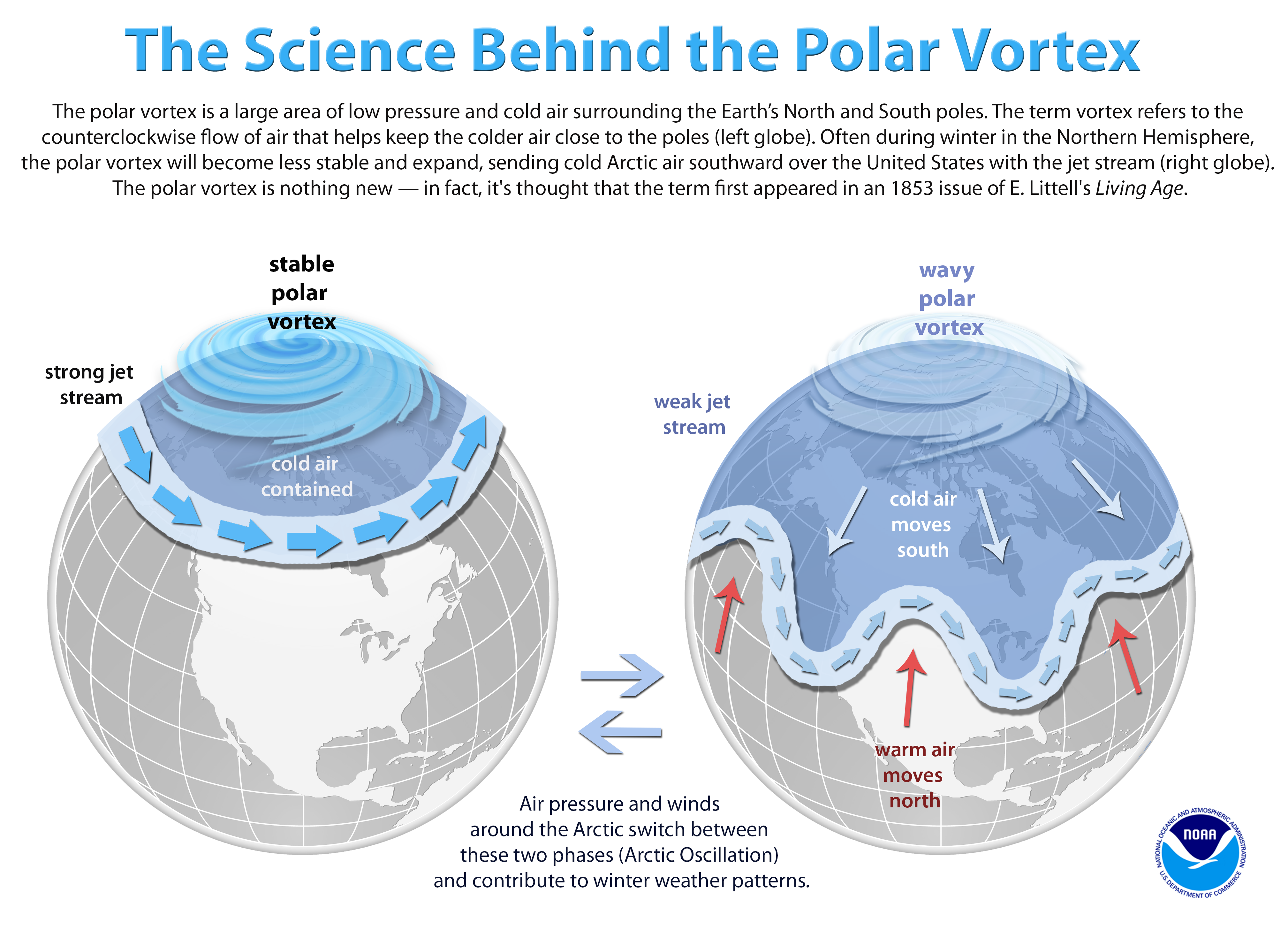
Image public domain via NOAA
Just because a polar vortex is a “normal” weather phenomena does not make it any less devastating.
Keep this in mind:
Having an emergency kit makes sheltering in place much better.
Superstorms
A superstorm is defined as:
“a very large and powerful storm”
Supposedly coined in March of 1993, the term “superstorm” was first used by the National Weather Service to describe a Nor’easter.
As it turns out:
The word has been in use since 1919 according to the folks at Merriam-Webster.
Superstorm is the accepted term used to describe weather occurrences that are not classified as a specific type of storm.
A hurricane cannot be a superstorm — it is just a BIG hurricane.
Tornadoes, even when there are hundreds of them, cannot be a superstorm.
A blizzard cannot be a superstorm — it is just a BIG snow storm.
While superstorms are increasing in frequency, when your local weather forecaster labels every blizzard as a superstorm, it only serves to lessen the impact of the warning when an actual superstorm materializes.
Remember what happened to the young shepherd boy:
History of the Emergency Kit
Survival kits in some form have been around since the dawn of time.
Some of the items carried by primitive man could have been considered an emergency kit:
You need to do something about it.
- Hoko knives
- Stone hammers and tomahawks
- Spears
- Bows and arrows
- Rock slings, and
- Axes
Keeping these tools and weapons close at hand allowed nomadic tribes to survive and thrive no matter what situation they found themselves in.
Since then, the evolution of emergency kits is an on-going process.
It is a method that the military has used in every successful deployment, during wartime and peacetime operations.
The basic premise is:
To have everything you might need in one place.
Grab it and GO!
Over time, our concept of emergency kit has changed:
Following major disasters such as Hurricane Andrew in Florida and Katrina in Louisiana, the problems incurred caused a new approach.
People realized that an emergency kit needs to contain much more than food, water, and a few changes of clothing.
Living in a disaster-prone area means being prepared for the possibility of a complete, and sometimes permanent, relocation.
That means extensive planning.
Be Santa — make a list and check it twice.

Survivalist tie-in
Survivalists created the terms:
- Bug Out Bag (BOB)
- Get Out of Dodge (GOOD) kits
- Personal Emergency Relocation Kits (PERKs)
And because a survivalist thinks in the long-term, they construct their kits with the thought of extended forays into the wilderness.
This makes a huge difference:
Most often contained in backpacks, a survivalist’s emergency kit is more portable than a family-based emergency kit prepared for natural disasters.
Likewise, the equipment they contain is geared toward using basic survival skills and living in the wilderness for a significant period.
Like, a lifetime.
TEOTWAWKI
TEOTWAWKI (Tee-Oh-Twaw-Kee) is short for “The End of the World as we Know it.” While it is often laughed off as nothing more than a prepper conspiracy theory, it bears mentioning.
Solar flares have temporarily disrupted cell phone signals, radio and television transmissions, and even satellite communications.
In the event of extended interruptions, the impact would resemble:
TEOTWAWKI
It may not be as devastating as the doomsday predictions, but it will affect you.
Think about it:
Our society is dependent on the constant connection to one another.
We are addicted to constant access to the news cycles and the internet.
Without that connection, there would be an instant sense of confusion.
Evolution of the Emergency Kit
We briefly discussed how the emergency kit is evolving.
What started as grabbing a few changes of clothing, some snack foods, and a few dollars has evolved into a full-scale preparation to completely relocate if necessary.
FEMA, the CDC, and the American Red Cross have developed emergency kit packing lists with recommendations of what to include.
Food, water, and even the dog’s food bowl are on the list.
While the emergency kit lists have been available for a long time, most received major revisions after the lessons learned from major storms.
Hurricane Katrina

“Hurricane Katrina, which caused an estimated $200 billion dollars in damage, is the costliest natural disaster so far this year. It is also the costliest natural disaster in U.S. history.”
Nearly 80 percent of New Orlean’s 485,000 residents evacuated when they received the order.
When almost 10,000 people thought they were safe in the Superdome, parts of the roof was ripped off by 100 miles per hour winds.
Hurricane Katrina raged across the south, causing death and destruction in Florida, Alabama, Mississippi, and Louisiana.
The sheer enormity of this storm caused the entire nation to step back and take stock.
The biggest lesson we learned from Hurricane Katrina was that we needed to be better prepared.
As individuals. As a nation.
Consequently, the evolution of the emergency kit went into overdrive after Katrina in 2005.
Due to what we learned during and following Hurricane Katrina, future storms were handled better.
Hurricane Sandy
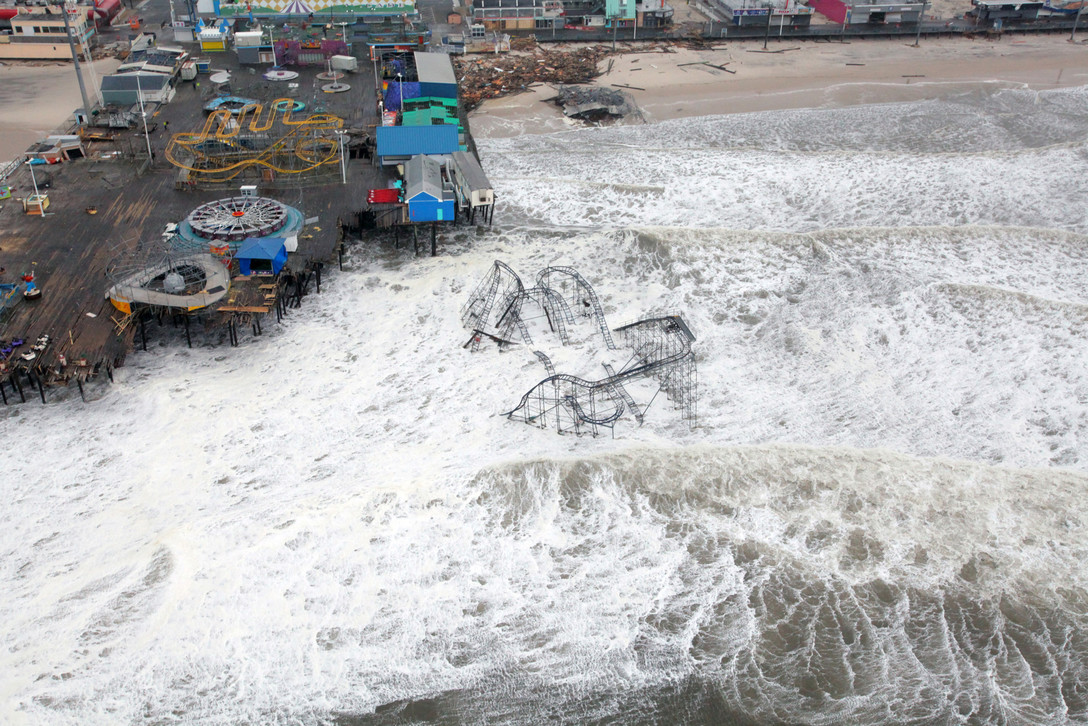
Image public domain, by Master Sgt. Mark C. Olson, via U.S. Air Force
Hurricane Sandy cruised along on her path of destruction from Oct 22, 2012, until Nov 2, 2012.
Often miscategorized as a superstorm, Sandy was just a routine, albeit HUGE, hurricane.
| Category 1 | 74 to 95 mph (119 to 153 km/h) |
|---|---|
| Category 2 | 96 to 110 mph (154 to 177 km/h) |
| Category 3 | 111 to 129 mph (178 to 208 km/h) |
| Category 4 | 130 to 156 mph (209 to 251 km/h) |
| Category 5 | 157 or higher mph (252 or higher km/h) |
Resource link for info in table: https://www.livescience.com/57671-hurricane-season.html
But that’s just part of the story:
Hurricane Sandy, a large Category 2 storm, was barreling toward the New Jersey and New York shoreline on October 29.
The entire Atlantic seaboard was in a panic.
While still a massive storm system, Sandy was downgraded to a post-tropical cyclone by the time she made landfall.
A sigh of relief was heard around the nation, but that wasn’t the last of it:
Still reeling from the effects of Hurricane Sandy, the area was hit by a Nor’easter that had powered up with the remnants of the hurricane.
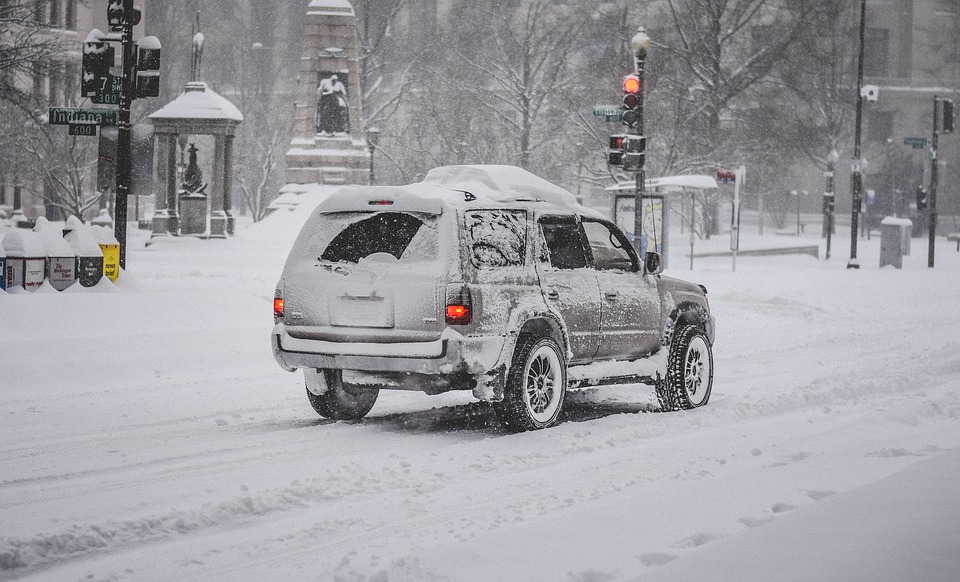
A nor’easter is a strong low-pressure system consisting of powerful northeasterly winds.
The collision of the two systems exacerbated the already catastrophic damage.
But it could have been a lot worse.
Many people had prepared for the storm because of Katrina.
As a result:
The evolution of the emergency kit continues.
Marking Yourself “Safe” from Whatever
If you frequent Facebook, Twitter, or Instagram, you’ve probably seen the posts denoting that whoever has been “Marked Safe From” whatever.
But here’s what happened:
Although sometimes done in a joking manner, such as those who marked themselves safe from caring about the Super Bowl, this trend began gaining traction during Hurricane Harvey.
It was a quick and easy way for people to let their friends and family know they were safe if they had been in the path of the storm.
The idea has been used since for hurricanes, tornadoes, earthquakes, and the recent California wildfires.
Expounding on that idea:
People who live in areas prone to natural disasters should consider setting up a communication network.
Whether you opt to use text messaging or one of the many social media outlets, having a network for notifying family and friends is a good practice.
A network should include at least one central contact person.

Source: Author
When you’re in the midst of responding to a natural disaster, the last thing you want (or need) to be doing is contacting 23 people to relay the exact same message.
This simple solution keeps family and friends updated without putting added stress on the person going through the emergency.
Packing Your Emergency Kit
We mentioned earlier that you wouldn’t need 52 cans of tuna in your emergency kit.
But you do need to plan for adverse natural disasters.
They will happen.
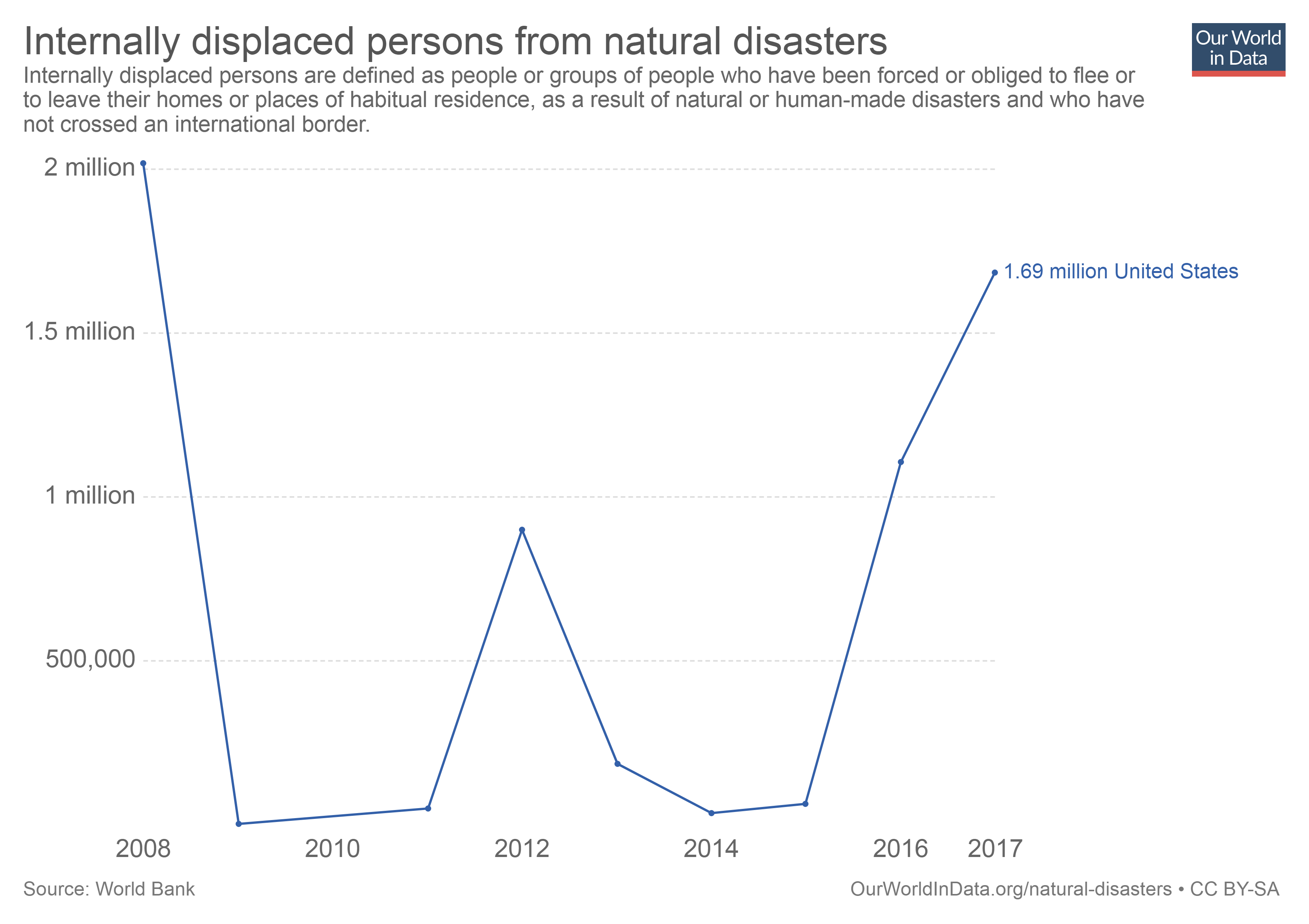
Image: CC BY-SA 4.0 via Our World in Data
Everything we have mentioned thus far points to one single fact:
You need to have an emergency kit and a plan for your family.
While natural disasters seem to be on a downswing of frequency, their strength and total impact continue to increase.
There were a total of 1.69 MILLION people displaced in the United States in 2017.
What does this mean for you?
Eventually, an emergency or natural disaster will affect your family.
Will you be ready?
Is your emergency kit prepared?
We can help.
Important papers
Many people forget to include important papers in their emergency kit.
You will need these.
It is much easier to rebuild if you have the appropriate documentation with you.
With that in mind:
When in doubt — pack it out.
Household, vehicles, and bank accounts
When you pack, you can’t take it all, but you need a significant number of very important papers with you.
Since these can’t live in the utility room closet with the rest of your emergency kit, they should be kept in an easy-to-access file.
That means:
When it is time to leave, you can easily find what you need, place it in a watertight bag, add it to your emergency kit, and check it off your pack-out list.
HELPFUL HINT
Keep copies of individual identification documents such as drivers’ licenses, Social Security cards, and insurance with your main paperwork.
Individual adults should be responsible for their own drivers’ license, Social Security card, passports, and bank account information.
Types of Important Papers you Need
- Drivers licenses for ALL licensed drivers
- Passports for everyone in your family
- Pet registrations and records of vaccinations
- Immunization records for all minor children
- School transcripts, or most recent report card for children
- Medical information for family members with specific medical needs
- Medical and Life Insurance cards and policies
- Social Security cards
- Contact list (on actual paper) with names/phone numbers for family/friends
- Vehicle registrations, titles, and insurance information
- Mortgage paperwork, property deed, and utility information
- ALL bank account numbers and information (again, on real paper)
- Checkbook and several working pens
The above list might seem extensive.
But consider this:
You may never return to that home again.
Or it may be flooded, or damaged, ruining everything you left behind.
Medications and first aid supplies
Don’t forget basic medicines.
This includes the allergy tablet you take every morning, vitamins, Tylenol, aspirin, or Ibuprofen.
Any over-the-counter medications you and your family rely on should be included on this list.
The tablets that turn your kid’s teeth blue so they can see where their toothbrush missed? Those you can leave behind.
Yeah, we’re going there:
Prescription medications shouldn’t have to be mentioned, but we’re doing it anyway.
You’ll remember the ones you take daily, but what about the “As Needed” ones?
Just because you haven’t needed them for three months doesn’t mean you’re not going to need them during this emergency.
HELPFUL HINT
It may be a little bulkier, but keep ALL prescription and OTC medications in their pharmaceutical bottles or packaging. If you need to enter a shelter, they will often not allow any medications that are not readily identifiable.
Assemble and keep a first aid kit ready.
This should include all the essentials such as band-aids, triple antibiotic ointment, a hydrocortisone cream or anti-sting treatment for bug bites.
It can be basic but should contain a well-rounded selection of supplies.
Contact lists with phone numbers
We talked about having a contact network earlier.
You also need to carry a contact list with you, in writing, on real paper in your emergency kit.
You have it in your phone, but what if the battery dies or what if you lose your phone?
The list should contain everyone that is on your family network contact list.
Then add your employment emergency numbers, and keep this in a safe and dry place.
When people from New Orleans evacuated during and after Katrina, some were bused across the country.
Imagine ending up in an entirely different state.
You know your Aunt Susie lives there somewhere, but you have no idea who to call to get in touch with her.
Paper. That’s where it’s at.
General packing lists for everyone
Because every family is different, every packing list will be different.
We compiled the most common items to help you organize a list for your family. It may seem to be a daunting task.
But here’s the deal:
It will be beneficial in the long run.
Children
Please… DO NOT FORGET TO PACK THE CHILDREN!
Of course, you won’t forget them.
But don’t forget their stuff either.
What to Pack for Your Children
- Clothing for 3 to 4 days
- Spare shoes (have them wear boots to conserve space)
- Medications, OTC or prescription
- A special toy, or something that comforts them
- Towel and washcloth
- Toothbrush, toothpaste, and personal items
- Flip flops/shower shoes
This will be a traumatic event for your child.
Generally, emergency shelters will have minimal space, but your children need something that comforts them.
Bring this:
A favorite blanket, stuffed animal, toy car — whatever it is — bring it.
If your children are old enough (5 or older), enlist their help.
This serves several purposes:
Keeping them busy will ease their mind and allow you a little space to do what you need to do.
Have a list for them, with words they can read, and checkboxes.
Have them collect everything on their list.
When they have collected everything, you should check the items and pack them in your child’s backpack.
Practicing before an actual emergency will also ease fears and apprehension for your child.
Pets
If you have to evacuate, ideally, your pets will be in carriers.
Don’t leave them behind.
They won’t be fine on their own.
What to Pack for Your Pets
- Clothing (if they have it, bring it)
- Medications, OTC or prescription for fleas, heartworm, etc.
- A special toy, or something that comforts them
- Towel (to dry them if they get wet)
- Any hygiene items your pet might need
- Food and Water bowls
- Food for 3 – 5 days
- Treats for good behavior
- Collar (they should be wearing this) and leash
- Baggies for — ummm — stuff
Your pets can’t help pack.
But your kids can:
If your children are old enough, have a list of pet care items for them.
Same rules
Survivalists created the terms:
- Use wording that your child can read
- Add checkboxes (it’s a thing with kids, trust me, you need checkboxes)
- When done, check to make sure they have everything and pack the items
Again, allowing your children to help will make them less apprehensive.
Emergency equipment
The things on this list can be pre-staged and sit in the utility closet or garage all year.
All of your emergency supplies should be in one storage location if possible.
Plastic bins are an excellent option for storage of emergency supplies. They can easily be accessed and should be checked at least twice a year.
If you need to evacuate, they can be loaded directly into a vehicle.
Here is what you need:
What Emergency Supplies to Pack
- Flashlight (check batteries)
- 550 Paracord
- Matches (in an air- and water-tight container)
- Firestarter tool
- Sharp knife (hunting knife or folding pocket knife)
- Tarps or survival blankets
- Blankets or sleeping bags — one for everyone
- Tent (if you have one)
- Hand crank radio with NOAA band
- Rain gear (boots and ponchos)
- Paper maps (because your GPS may not work)
- Compass
- Whistle
- Paper and Wooden pencils
- Baby wipes
- Can opener (the manual kind)
- Pliers and small hand tools (a small set with a variety)
These are the supplies that will allow you to protect your family.
If it seems like a general purpose list you might make for a family camping trip you are not wrong.
While optional, every item in this section is designed to allow your family to set up in any safe location.
If all the available shelters are full, you will bless that tent.
If you are driving and nothing is available, you will bless that tent.
When you stop to feed everyone and reach for one of those cans of tuna, you will bless that can opener.
Non-perishable food
Non-perishable food means food that had a long shelf life.
This used to mean tuna, but now, the options are plentiful.
Taking a cue from the military, many companies have developed complete food lines consisting of GOOD FOOD.
These freeze dried options offer complete meals.
And that’s not the best news:
They are also COST EFFECTIVE!
Meals generally average out to $2 to $4 per serving.
This list will need some customization from you.
Look for foods that store well and your family won’t think are poison. Also, check and rotate your emergency kit food items at least twice yearly.
What Food and Supplies to Pack

What Emergency Supplies to Pack
- Plan meals for three days for your entire family
- Plan snacks (beef jerky and fruit snacks are good)
- Bottled water (1 gallon per person for three days — don’t forget your pets)
- Don’t forget a pan or pot
- Paper plates, cups, plastic utensils
- Paper towels
Our list is not complete.
We know this.
Add the things that your family needs and eats.
Add clothing and hygiene items for all adults.
Don’t forget food and extra water for your pets.
Cash
In addition to all your bank information, bank cards, checkbook, and everything on your list — don’t forget cash.
You know, that green stuff people don’t use anymore.
You might need it.
With power outages, Automatic Teller Machines (ATMs) won’t be accessible, banks probably won’t be open, and credit card machines at the local grocery store may not be working.
In short:
Bring cash. Several hundred dollars at least.
The bigger your family, the more you should have socked away.
Have a Written Plan
Our important papers usually reside in a file cabinet or safe.
We normally don’t keep them in a watertight bag in the bottom of the utility room closet.
Develop a written plan:
Having a complete checklist is the best way to make sure that you have everything you might need.
HELPFUL HINT
Keep a list out and accessible for the entire family. They can add things as they think of them over a few days. Then the list can be streamlined and organized. By gathering input from the entire family, you have a better chance of remembering everything.
While we tried to add everything to our suggested lists, each family will have specific items that aren’t included in our lists.
Each family member should have a personal list containing the items they need.
As you continue to develop your emergency kit and plan, you will see as it evolves into the perfect plan for your family.
Perform practive drills with your children
Prepare children for what they may face, and mention things you might have to do.
Discuss what the emergency is and establish your plan as a family.
Above all:
Reassure them that you, another adult, or an older sibling will be there to help them. Also, make sure they understand the importance of staying close.
During practice drills:
Give them specific tasks and let those tasks be their responsibility.
It is amazing how “grown up” a 5-year-old can be when you give them the opportunity.
Developing your checklist
Make sure to include the things that your family needs.
Building your emergency kit can be a bonding experience.
Everyone has different things that are important to them.
While you can’t bring everything, it is important that individuals have at least one small item that comforts them.
This includes adults.
Your emergency kit will be streamlined for your family.
We found some helpful videos:
But remember:
This is YOUR EMERGENCY KIT.
Make it perfect for your family.
Setting up a Schedule to Check and Replenish your Emergency Kit
Last, but certainly not least:
Set up a schedule to check your emergency kit.
A good time to do this is when the clocks move for Daylight Savings Time.
Like the batteries in your smoke detectors, establishing a habit will make sure that your emergency kit is in good shape when you need it most.
Make sure that food expiration dates are good, rotate your bottled water for new, and double-check your packing list.
But that’s not all:
Make sure you add new kids or new pets as needed, and check the phone numbers on your contact list and update if necessary.
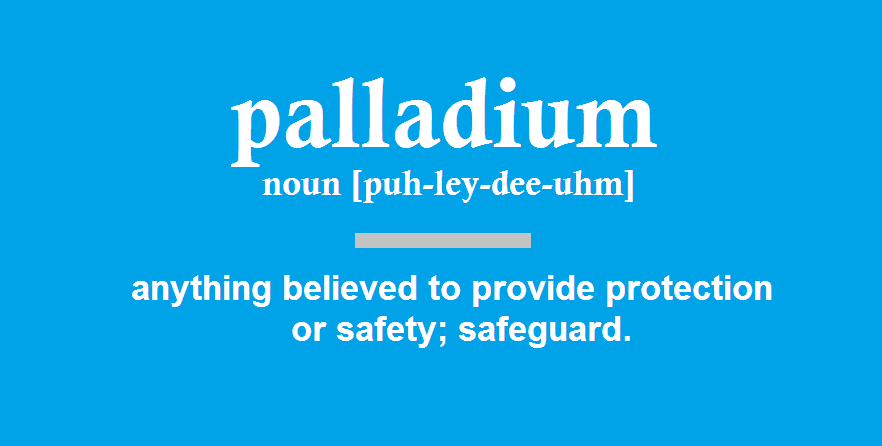
Source: Author
Your emergency kit is your personal palladium.
It will provide protection for you and your family.
It will safeguard you from calamity.
While we hope you never need it, but it will prove invaluable if you do.
Do you have an emergency kit? Have you ever had to use it? Let us know in the comments!

Leave a Reply